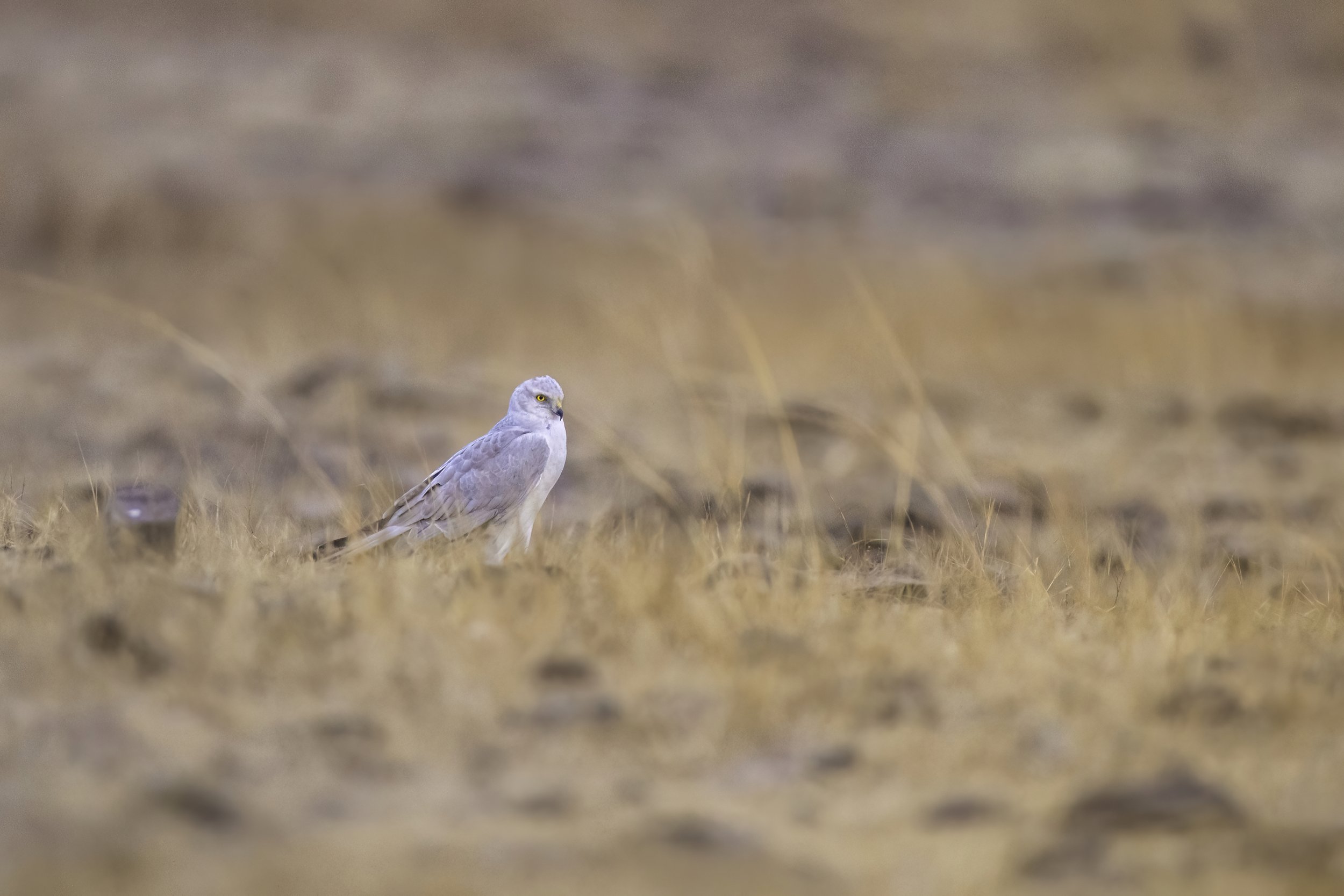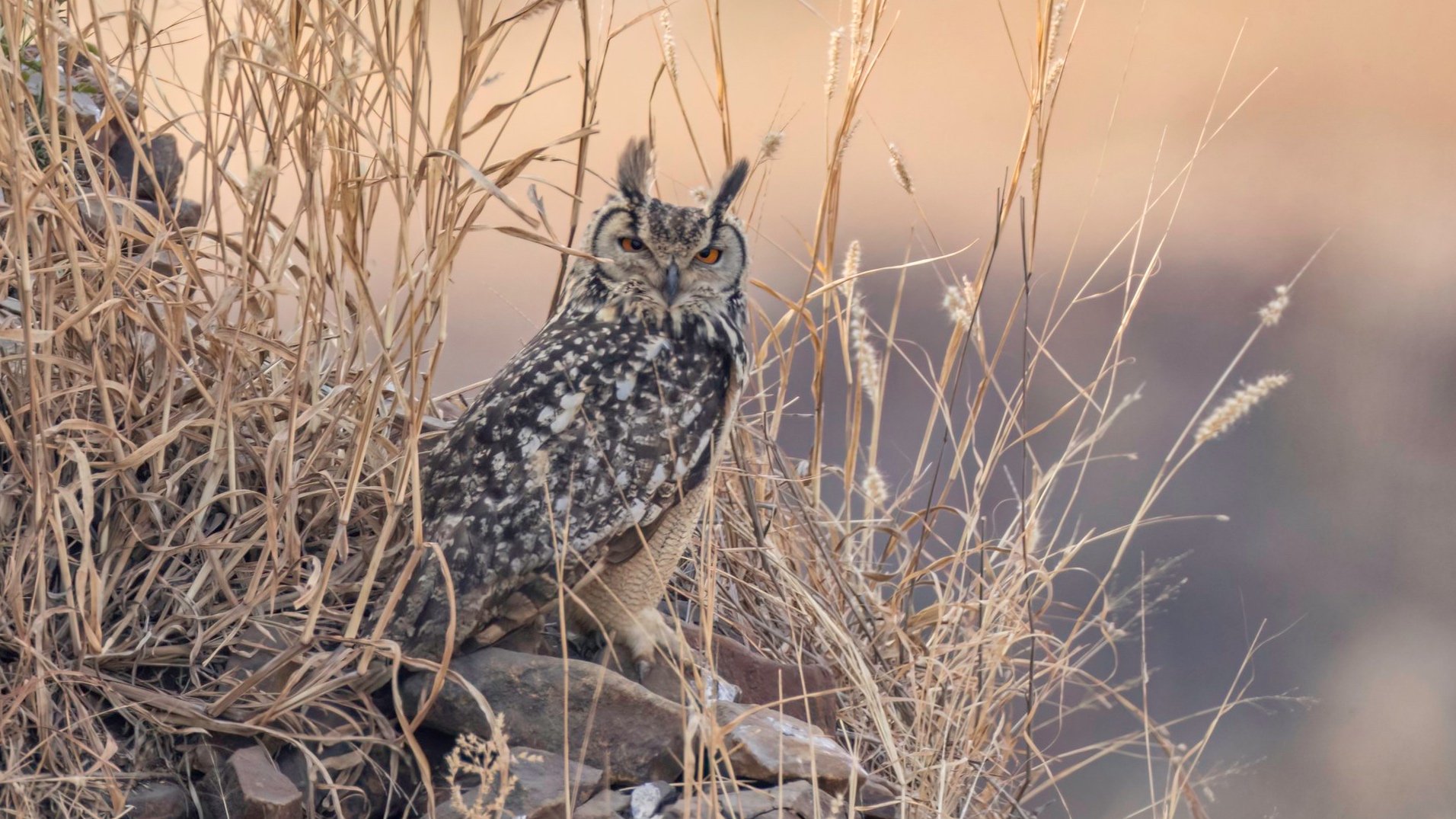Pallid Harrier
Circus macrourus
NEAR THREATENED
The harriers of Kumbhargaon
The first of a three harrier series.
Bhigwan Bird Sanctuary
After the series on the magnificent eagles of Kumbhargaon, it is now time for the smaller raptors - the harriers - inhabiting these lush grasslands. The area around Bhigwan and the River Bhima is vast and unique with diverse habitats ranging from the shallow wetland ecosystem of the Ujni backwaters to the surrounding rich farmlands and dry deciduous scrub forest with interspersed grasslands. The rich grasslands and fertile farms are home to an equally impressive list of birds, mammals and reptiles. They protect many mammals like the Chinkara, Hyena, Wolf and Indian fox. It is also popular for grassland birds and the birds of prey, including the eagles I have talked about in the earlier blogs, the endangered Steppe Eagle, the vulnerable Greater Spotted Eagle and the rare & also vulnerable Eastern Imperial Eagle.
The harriers are any of the several species of diurnal hawks sometimes placed in the subfamily Circinae of the bird of prey family Accipitridae. They characteristically hunt by flying low over open ground, feeding on small mammals, reptiles, or birds. The young of the species are sometimes referred to as ring-tail harriers. They are distinctive with long wings, a long narrow tail, the slow and low flight over grasslands and skull peculiarities. The harriers are thought to have diversified with the expansion of grasslands and the emergence of C4 grasses about 6 to 8 million years ago during the Late Miocene and Pliocene
The genus Circus was introduced by the French naturalist Bernard Germain de Lacépède in 1799. Most harriers are placed in this genus. The word Circus is derived from the Ancient Greek kirkos, referring to a bird of prey named for its circling flight (kirkos, "circle"), probably the hen harrier. The name harrier is thought to have been derived either from Harrier (dog), or by a corruption of harrower, or directly from harry. Ring-tail is an informal term used by birders for the juveniles and females of several harrier species when seen in the field and not identifiable to an exact species. Ring-tail harriers include the juveniles and females of Montagu's harrier (Circus pygargus) - to be a later blog in this series, hen harrier (Circus cyaneus), and pallid harrier (Circus macrourus).
During our time here we were hosted by and had the expert help of Sandip Nagare and his team of knowledgeable guides from the Agnipankha Bird Watcher group, especially Ganesh Bhoi, who went out of their way to ensure we had fantastic opportunities to explore, discover, observe & photograph over 82 species of birds and wildlife including some rare ones. We stayed at Sandip’s homestay of the same name and had the added pleasure of indulging in delectable home cooked food.
With that as the prelude I have this blog as the first chapter of a three part series on the harriers of the Kumbhargaon grasslands starting with the Near Threatened Pallid Harrier.
‡‡‡‡‡
The Pallid Harrier
The pale or pallid harrier (Circus macrourus) is a migratory bird of prey of the harrier family. As I mentioned before the scientific name is derived from Ancient Greek. Circus is from kirkos, referring to a bird of prey named for its circling flight (kirkos, "circle") and macrourus is "long-tailed", from makros, "long" and -ouros "-tailed". This is a typical harrier, with long wings held in a shallow V in its low flight. It also resembles other harriers in having distinct male and female plumages. Males are ghostly gray above with black wingtip wedges. Females more difficult to separate from other harriers; pay attention to the underwings with their barred primaries and dark secondaries. Juveniles are rufous and similar to Montagu’s, but appear dark rather than pale faced. In flight, a bit bulkier than Montagu’s but much more buoyant than Hen Harrier. Found in steppes, wet grassland, and agricultural areas it breeds mainly in Eastern Europe but increasingly recorded in Western Europe.
It breeds in southern parts of eastern Europe and central Asia and Iran and winters mainly in India and southeast Asia. It is a very rare vagrant to Great Britain and western Europe. This medium-sized raptor breeds on open plains, bogs and heathland. In winter it is a bird of open country.
Pallid harriers hunt small mammals, lizards and birds, surprising them as they drift low over fields, grasslands and moors.
Pallid Harrier Range
During breeding, the pallid harriers are found mainly on natural grassy plains and dry steppes in flat or undulating terrain or on slopes, valleys with steppe vegetation and semi-desert, occasionally in agricultural areas, preferring wet grassland near small rivers or lakes or marshland for nesting. In winter it uses similar habitats, but also others, for example unirrigated wheat fields or sandy islands in the Indus Delta (Pakistan), open woodland and mountain plateaux in West Africa; infrequently it visits marshes and rice paddies. Outside the breeding season it may reach up to 3000 m in the Himalayas, and rarely over 4000 m in Africa.
A small isolated population breeds in boreal forest and forest-tundra zones in west Russia north of the main range, nesting in clearings and other open areas. During migration and in winter quarters roosts communally, normally in grass, but also in open; groups of up to several hundreds together, sometimes along with Montagu’s harrier (C. pygargus) and/or Hen harrier (C. cyaneus).
The Pallid harrier is not globally threatened but is currently considered Near Threatened (Extinction Risk). It is suffering a steep population decline in Europe, but numbers are believed to be more stable in the Asiatic strongholds; probably in moderately rapid decline overall. The estimated global population in the first years of the 21st century 9000–15,000 pairs, with a great majority breeding in the Asiatic steppes in Russia, Kazakhstan and NW China, with small and apparently diminishing populations in the surrounding regions of Europe in Finland, Romania, Ukraine, W Russia, Turkey (where only very rarely proven to breed) and Azerbaijan. BirdLife reports that, in 2007, six pairs bred in Moscow region for very first time. Numbers in Asia believed reasonably stable.
The European population put at 310–1200 pairs; after a big decline during 1970–1990, when up to 30% of individuals lost (especially from the main population, in European Russia), numbers continued to fall in following decade up to 2000, and general trends of loss exceeded 30% over next three generations (18 years). Bred formerly in Belarus and Moldova, but apparently now extinct in both. The fact that numbers on breeding grounds fluctuate in response to changes in surrounding environment (such as, especially, numbers of small mammals available) makes assessment of this raptor’s status difficult; high or low numbers of this harrier in any year or two-year period could indicate change in its demographics or could be indicative of change in local environment, and pairs could, of course, move to other areas (which would not affect population size).
The main threat in the breeding range is degradation and destruction of steppe grasslands by conversion to arable farming, burning of vegetation, intensive grazing of wet pastures, and clearance of shrubs and tall “weeds” (fires started by farmers and arsonists, as well as by dry thunderstorms). On non-breeding grounds, the loss of grassland through burning, cutting and overgrazing is the principal problem; pesticides, rodenticides and other toxic chemicals are also thought to have an adverse effect on this species, although further research is required.
Proposed conservation actions include efforts to protect wetlands in steppe grassland and semi-desert, and support for moderate grazing and conservation of grasslands. Surveys are required in order to determine full extent of breeding range and to gain accurate estimate of population, and research is needed on the species’ diet and foraging-range size, and how these influence its movements. Legislation banning use of harmful pesticides in non-breeding ranges, and in recovering agricultural economy in breeding range, is an urgent necessity. In non-breeding range, fieldwork to locate major roosting aggregations in Africa and India is desirable, with subsequent conservation measures taken if necessary. Full legal protection is required in countries on the species’ migration routes and in its winter range, and public-awareness programmes should be initiated where appropriate especially in countries like India.
The Kumbhargaon and Birgundwadi grasslands are abundant and rich and prime habitats for the Pallid and other harriers. But it is saddening to observe and watch hordes of tourists, “wildlife” & “bird“ photographers chase these birds all over the area. A few tracks cut across the grasslands but most drivers - and this is my observation during my time here - drive recklessly over the grasslands refusing to listen to any reasoning. This included my driver who insisted on driving as close as possible to the harriers, more often than not, scaring them off. I had to finally tell him I could use extenders and he didn’t need to get within a few feet of the birds for me to get my photo. Who’s to tell the other drivers, pushed to drive in such fashion by their clients, all for the sake of a few photos shared on Instagram or Facebook.
If these grasslands are destroyed by such reckless trampling, these beautiful birds will no longer be seen, period!
The Pallid Harrier is classified as Near Threatened (NT), is close to qualifying for or is likely to qualify for a threatened category in the near future.
‡‡‡‡‡
The following are some photos of the male & female Pallid Harrier recorded at the Kumbhargaon and Birgundwadi grasslands.
The first set of photos are of the male as he perched on rocks across the grasslands.
We first saw the female Pallid perched to the left and behind a Montagu’s harrier. She then took off and perched in the grass. The way she was sitting I suppose she had a kill or something there that held her attention for quite a while.
The following images were made quite late in the evening as the sun had set and the last glow faded into darkness.
The following were shot at ISO 25,600 at a shutter speed of 1/640 and f8 a focal length of 1200mm.
The following footage was recorded on 12th February across the grasslands of Birgundwadi near Kumbhargaon. It is truly an honour and privilege to be able to get close to and watch these beautiful birds of prey.
For more videos: Video Shorts
Related Posts










